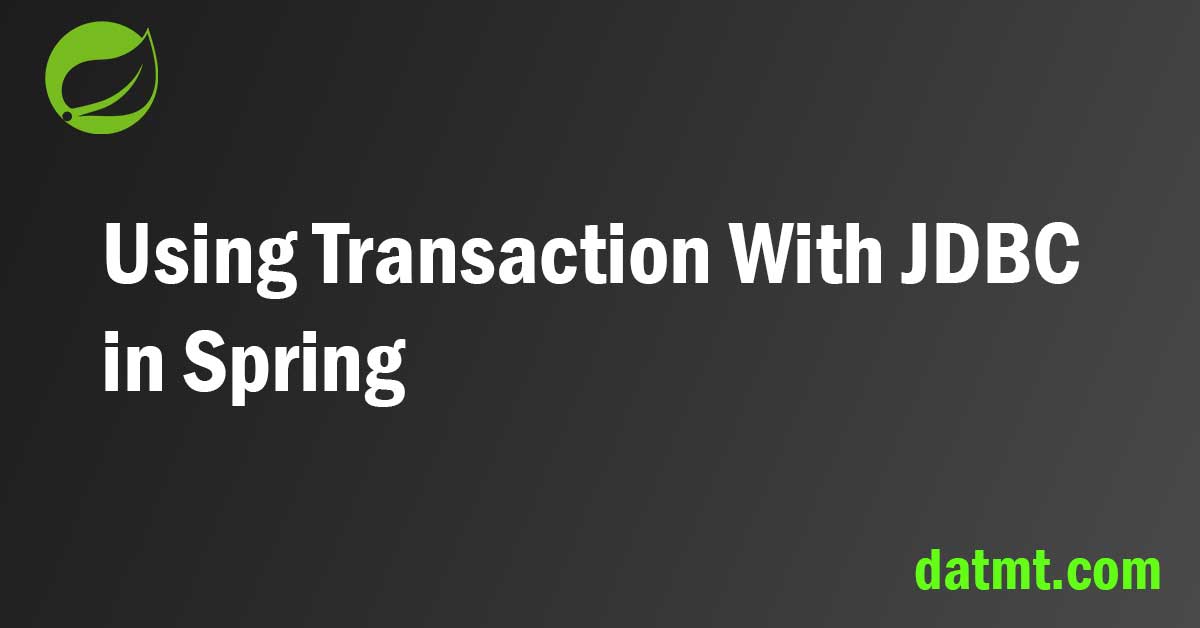Table of Contents
Overview
In the first post of this series, I briefly discussed the problem with multiple database operations and the need for using transaction management. In the last post, I also showed you how to set up PostgreSQL database using docker-compose.
In this post, I’m going to show you the problems and solutions with code.
The data model
As mentioned in the first post, I’m going to use the bank transfer scenarios to demonstrate transactions.
Let’s first create the table in PostgreSQL:
CREATE TABLE IF NOT EXISTS bank_user (
id serial8,
balance bigint,
name varchar(50)
)Next, let’s insert Alice and Bob into the table. They all have an initial balance of 100:
insert into bank_user (name, balance) values ('Alice', 1000);
insert into bank_user (name, balance) values ('Bob', 1000);Now, I have both Alice and Bob in the table and they all have 1000 credits:

Let’s create a test to make sure the data in the database is what we expected:
package com.datmt.springdata.springdatajpatransactional;
import com.datmt.springdata.springdatajpatransactional.config.AppConfig;
import org.junit.jupiter.api.BeforeAll;
import org.junit.jupiter.api.Test;
import org.junit.jupiter.api.TestInstance;
import org.springframework.context.ApplicationContext;
import org.springframework.context.annotation.AnnotationConfigApplicationContext;
import javax.sql.DataSource;
import java.sql.Connection;
import java.sql.SQLException;
import static org.junit.jupiter.api.Assertions.*;
@TestInstance(TestInstance.Lifecycle.PER_CLASS)
public class CreditTransferWithoutTransaction {
private final ApplicationContext context = new AnnotationConfigApplicationContext(AppConfig.class);
private final DataSource datasource = (DataSource) context.getBean("default_datasource");
@BeforeAll
void setup() throws SQLException {
Connection connection = datasource.getConnection();
connection.createStatement().executeUpdate("UPDATE bank_user set balance = 1000");
connection.close();
}
@Test
void test_query_existing_initial_data() throws SQLException {
Connection connection = datasource.getConnection();
//get alice details
var aliceStatement = connection.createStatement().executeQuery("SElECT * FROM bank_user WHERE name = 'Alice'");
var bobStatement = connection.createStatement().executeQuery("SElECT * FROM bank_user WHERE name = 'Bob'");
if (aliceStatement.next() && bobStatement.next()) {
var aliceAmount = aliceStatement.getLong("balance");
var bobAmount = bobStatement.getLong("balance");
assertEquals(1000L, aliceAmount);
assertEquals(1000L, bobAmount);
} else {
fail("Bad data in the database");
}
}
}
As you can see, at the beginning of all tests, I reset the amount of both Alice and Bob to 1000. The next test ensures that I’m able to pull the data and verify both Alice and Bob have 1000 credit each.
Let’s perform a money transfer from Alice to Bob. Here are the steps:
- Withdraw credits from Alice (100)
- Deposit credits to Bob’s account(100)
Suppose after a successful withdrawal, an exception in code occurs.
Here is the code:
@Test
void test_transfer_money_with_exception(){
try (Connection connection = datasource.getConnection()) {
//withdraw credits from Alice's account
connection.createStatement().executeUpdate("UPDATE bank_user SET balance = 900 WHERE name = 'Alice'");
//Simulate an exception
if (true) {
throw new RuntimeException("Opps! System crashes...");
}
connection.createStatement().executeUpdate("UPDATE bank_user SET balance = 1100 WHERE name = 'Bob'");
} catch (SQLException ex) {
//
} catch (RuntimeException ex) {
//
System.out.println("Got a runtime exception");
}
}
In this code, I first withdraw credits from Alice’s account then intentionally throw an exception to simulate a system error. The update on Bob’s account, thus, never happens.
Checking the database and sure enough, you can see data is not in a consistent state. Before the transaction, Alice and Bob had a total of 2000 credits, now they only have 1900.

Someone has to fix that!
Low-level transaction management with JDBC
You can mitigate the issue above using JDBC only.
To create a transaction, you first need to set autocommit to false. What is autocommit then? If enabled, the changes persisted in the database after every statement, which is not what you want.
Here is the code that uses JDBC transaction management :
@Test
void test_transfer_money_with_transaction_management() {
try (Connection connection = datasource.getConnection()) {
connection.setAutoCommit(false);
//withdraw credits from Alice's account
connection.createStatement().executeUpdate("UPDATE bank_user SET balance = 900 WHERE name = 'Alice'");
//Simulate an exception
if (true) {
throw new RuntimeException("Opps! System crashes...");
}
connection.createStatement().executeUpdate("UPDATE bank_user SET balance = 1100 WHERE name = 'Bob'");
connection.commit();
} catch (SQLException ex) {
//
} catch (RuntimeException ex) {
//
System.out.println("Got a runtime exception");
}
try (
Connection connection = datasource.getConnection();
) {
//get alice details
var aliceStatement = connection.createStatement().executeQuery("SElECT * FROM bank_user WHERE name = 'Alice'");
var bobStatement = connection.createStatement().executeQuery("SElECT * FROM bank_user WHERE name = 'Bob'");
if (aliceStatement.next() && bobStatement.next()) {
var aliceAmount = aliceStatement.getLong("balance");
var bobAmount = bobStatement.getLong("balance");
assertEquals(1000L, aliceAmount, "Alice still has 1000 credits");
assertEquals(1000L, bobAmount, "Bob still has 1000 credits");
} else {
fail("Bad data in the database");
}
} catch (SQLException ex) {
//
}
}
Sure enough, the tests passed and both Alice and Bob still have 1000 credits in their account:

Use PlatformTransactionManager to manage transactions
Spring Framework provides an interface named PlatformTransactionManager to help developers with managing transactions. This is the common interface for many kinds of transactions (including JPA, JMS).
There are three methods in this interface you can use to manage transactions:
- commit
- rollback
- getTransaction
Here are some notable implementations:
| DataSourceTransactionManager | Suitable for managing transactions of a single data source |
| JtaTransactionManager | This transaction manager is appropriate for handling distributed transactions, i.e. transactions that span multiple resources, and for controlling transactions on application server resources (e.g. JDBC DataSources available in JNDI) in general |
| HibernateTransactionManager | This transaction manager is appropriate for applications that use a single Hibernate SessionFactory for transactional data access |
Since I’m using a single data source, I will configure a DataSourceTransactionManager bean in the AppConfig class:
@Bean(name = "datasource_tx_manager")
public DataSourceTransactionManager transactionManager() {
return new DataSourceTransactionManager(dataSource());
}Now let’s use this transaction manager to make Alice and Bob less unhappy (since the money is still not transferred).
private final ApplicationContext context = new AnnotationConfigApplicationContext(AppConfig.class);
private final DataSource datasource = (DataSource) context.getBean("default_datasource");
private final PlatformTransactionManager txManager = (DataSourceTransactionManager) context.getBean("datasource_tx_manager");
@Test
void test_transfer_money_with_platform_transaction_management_using_jdbc_template() {
try {
var definition = new DefaultTransactionDefinition();
var status = txManager.getTransaction(definition);
var jdbcTemplate = new JdbcTemplate(datasource);
//withdraw credits from Alice's account
jdbcTemplate.update("UPDATE bank_user SET balance = 900 WHERE name = 'Alice'");
//Simulate an exception
if (true) {
throw new RuntimeException("Opps! System crashes...");
}
jdbcTemplate.update("UPDATE bank_user SET balance = 1100 WHERE name = 'Bob'");
txManager.commit(status);
} catch (RuntimeException e) {
//
}
//extract to method to validate the amount of ALice and Bob in the database
validateAliceAndBobAmount(1000L, 1000L);
}
Here I use JdbcTempalte instead of creating connections and statements as in previous examples. With transaction manager, the code is less verbose.
The data in the database is still consistent. When the exception occurred, the transaction manager rollbacks the previous operations.
Conclusion
In this post, I showed you how to manage transitions using JDBC and also the transaction manager interface of Spring to achieve data consistency. These methods work however, they are verbose. In the next post, I’m going to show you how you can use Spring AOP to achieve the same result with cleaner code.
The code for this tutorial is available on Github here.

I build softwares that solve problems. I also love writing/documenting things I learn/want to learn.
